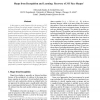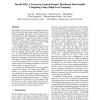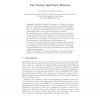868 search results - page 128 / 174 » Learning Object Representations Using Sequential Patterns |
ICDAR
2007
IEEE
14 years 4 months ago
2007
IEEE
The Machine Learning and Pattern Recognition communities are facing two challenges: solving the normalization problem, and solving the deep learning problem. The normalization pro...
CVPR
1999
IEEE
14 years 12 months ago
1999
IEEE
In this paper, a novel framework for the recovery of 3D surfaces of faces from single images is developed. The underlying principle is shape from recognition, i.e. the idea that p...
CVPR
2007
IEEE
14 years 12 months ago
2007
IEEE
Appearance Models (AM) are commonly used to model appearance and shape variation of objects in images. In particular, they have proven useful to detection, tracking, and synthesis...
OSDI
2008
ACM
14 years 8 days ago
2008
ACM
DryadLINQ is a system and a set of language extensions that enable a new programming model for large scale distributed computing. It generalizes previous execution environments su...
EUROPAR
2007
Springer
14 years 4 months ago
2007
Springer
Abstract. Algorithmic skeletons correspond to a high-level programming model that takes advantage of nestable programming patterns to hide the complexity of parallel/distributed ap...



